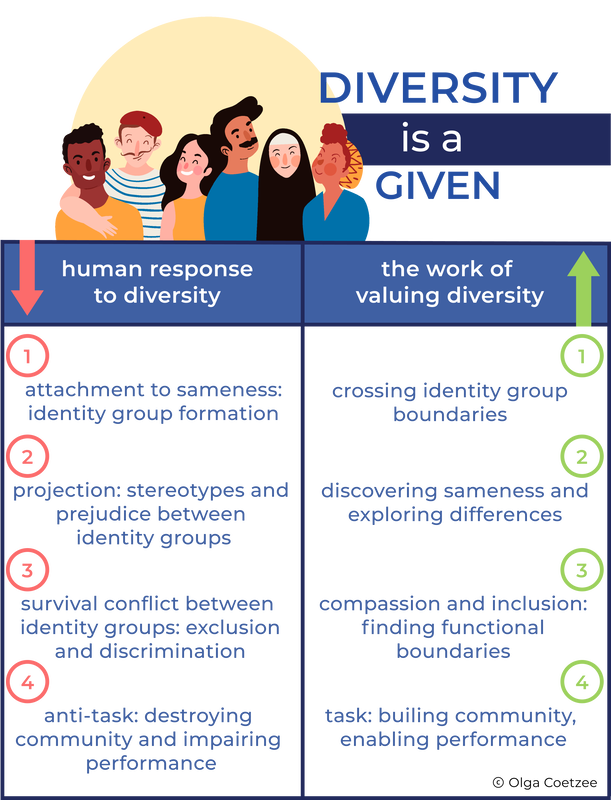VALUING DIVERSITY COMMUNITY BUILDING MODEL
The community model explains the normal human response to diversity which is self-protecting. It proposes an alternative, a more integrative way of living in diversity.
When humans are faced with diversity, they experience anxiety because of their fear of the unknown. In order to reduce their anxiety, humans attach themselves to others who are similar to themselves, i.e. they form identity groups on the basis of some or other diversity dimension like race, gender, age, religion, or sexual orientation. The unconscious drive is for the safety of familiarity. Identity groups then interact, invariably projecting their bad parts onto each other - this projection forms the basis of stereotyping and prejudicing.
Prejudice leads to conflict. In the case of identity groups, conflict often takes the form of exclusion and discrimination. In the organisational context, exclusion and discrimination destroys the organisational community, impairing the performance of employees, especially those in out-groups who end up feeling devalued. This chain of events relate to the normal human response to diversity.
What does the work of valuing diversity entail? Humans need to create and use opportunities to cross identity group boundaries. They are bound to discover sameness (we are all human) and through the recognition of sameness and common ground the liberty for exploring differences develop. This is when people really get to know each other.
When the fear of the unknown disappears, employees are bound to develop compassion for each other as humans and to display more inclusive behaviours within functional boundaries. Inclusion builds community in task groups, which in turn enables performance.
The community model explains the normal human response to diversity which is self-protecting. It proposes an alternative, a more integrative way of living in diversity.
When humans are faced with diversity, they experience anxiety because of their fear of the unknown. In order to reduce their anxiety, humans attach themselves to others who are similar to themselves, i.e. they form identity groups on the basis of some or other diversity dimension like race, gender, age, religion, or sexual orientation. The unconscious drive is for the safety of familiarity. Identity groups then interact, invariably projecting their bad parts onto each other - this projection forms the basis of stereotyping and prejudicing.
Prejudice leads to conflict. In the case of identity groups, conflict often takes the form of exclusion and discrimination. In the organisational context, exclusion and discrimination destroys the organisational community, impairing the performance of employees, especially those in out-groups who end up feeling devalued. This chain of events relate to the normal human response to diversity.
What does the work of valuing diversity entail? Humans need to create and use opportunities to cross identity group boundaries. They are bound to discover sameness (we are all human) and through the recognition of sameness and common ground the liberty for exploring differences develop. This is when people really get to know each other.
When the fear of the unknown disappears, employees are bound to develop compassion for each other as humans and to display more inclusive behaviours within functional boundaries. Inclusion builds community in task groups, which in turn enables performance.

